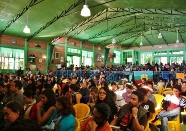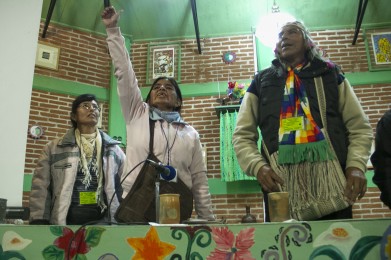
The representative of the National Indigenous Confederation of Ecuador (CONAIE), Severino Sharupi, assessed that the entry of his organization into state institutions and electoral processes had weakened them, even though they have achieved a new constitution and have ousted three presidents. Now, however, they have reactivated nationwide resistance against the extractive model promoted by President Rafael Correa.
![]() Source: Desinformémonos
Source: Desinformémonos
“History cannot be silenced. The roar of the silence of our Zapatista brothers and sisters has re-lit the fire of hope in even the most incredulous,” the philosophers Fernanda Navarro and Luis Villoro said, in a message sent to the Third International Seminar of Reflection and Analysis, “Planet Earth: anti-systemic movements.”
“After the silence they invite us, encourage us to walk the word, their word, to show what they have achieved resisting and building a world in which everything that has life is loved and respected, because it has heart,” they said in an emotional greeting in the final moments of the seminar.
Framed by three communiques issued by the Zapatista Army of National Liberation (EZLN) on the night of December 30 – one to civil society, one to the PRI and another to Louis H. Alvarez and the Panista government – the space for dialogue was developed at the premises of CIDECI-Unitierra, from December 30, 2012 to January 2, 2013. Certainly, the common reference point for attendees and speakers was the massive silent demonstration of the Zapatistas, held last December 21, the date on which they reappeared after more than a year of having no public actions.
The call to action for the movements came from thinkers and social activists from different countries, but all identified with the geography of below and to the left, who gathered to reflect on the alternatives and resistances that are built around the world in the face of the systemic crisis.
Representatives of experiences from places as diverse as Iran and France, the Wallmapu (Mapuche Country) and the United States, Argentina and Mexico, spoke of the need for immediate action to build the other world for which we struggle, meaning that Zapatista autonomy was a benchmark for the four-day seminar and for every intervention.
Crisis and opportunity
Pablo Gonzalez Casanova, former rector of UNAM and an intellectual who has been close to the Zapatistas for nearly two decades, said during his participation that it is fundamental to devise a vast network of organizations in defense of land and territory to confront the colonial policies of corporate capital. Given the crisis of the traditional left, he said, an other geometry has arisen, that of below and above.
In that sense, said González Casanova, the Zapatistas represent a new way of approaching problems and alternatives, beyond the old dilemmas of the left, defending life, water, land and forest.
Gustavo Esteva, founder of the University of the Earth in Oaxaca, said that capitalism has returned to the stage of accumulation by dispossession and will use the state “to protect themselves from their own excesses.” The process of dismantling the welfare state will dispense with all democratic practices and traditions, the new face of repression against those who defend their territory and inter-community conflict is to disguise it as inter-community conflict and send in hordes of attackers.
For Esteva, to regain hope is essential. However, he specified, “it is not about sitting around waiting for something to pull us forward,” but about imagining something , and putting it into practice immediately. “This is to dismantle the state apparatus by removing its need to exist,” said the scholar, and exemplified that “each and every Zapatista school is an autonomous center of knowledge production and makes Chuayffet and ‘The Master’ (Elba Esther Gordillo) unnecessary.” He noted that we must defend the Zapatistas, end sexism and, above all, realize that we are already in this new world.
François Houtart, Catholic priest and Marxist sociologist, greeted the Zapatista resistance noting that, concerning the possibility of building another system, there are those who say and those who do; the Zapatistas belong to the latter, and are an inspiration “to build another world,” he said.
The Belgian intellectual emphasized that we are at the end of an era because of the fundamental crisis of capitalism. “The casino economy will explode one day,” said the priest, who explained the contradiction between financial and artificial economics and the real economy. Houtart concluded that there is “widespread resistance against economic inequality and the system that has been built in the world,” and noted that this crisis of the logic of development is affecting the whole world: “we must not only find alternatives and regulations; we must completely rethink the reality of Earth and human reality.”
The ability to create another world, said Jérôme Baschet, the historian, is made possible by the convergence in the ability to create and expand free spaces and the deepening structural crisis of capitalism. The creation of a world composed of several worlds, he said, breaks the unifying logic of capital.
![]() The new world that already exists
The new world that already exists
The representative of the National Indigenous Confederation of Ecuador (CONAIE), Severino Sharupi, assessed that the entry of his organization into state institutions and electoral processes had weakened them, even though they have achieved a new constitution and have ousted three presidents. Now, however, they have reactivated nationwide resistance against the extractive model promoted by President Rafael Correa. Severino said it is no longer enough to resist, but “now is the time of the word, of rebellion and to take a step forward.”
Luis Carcamo, from the Mapuche community, presented the collective process by which the people learn to keep being Mapuche. Through two examples, a book and a radio, he showed how these tools can be used to support the territorial struggles, and political and cultural rights of his people, the Mapuche, “people of the earth”. He reported that the Mapuche political prisoners must use their bodies through hunger strikes to protest the anti-terror law enforced against them.
Andres Cuyul, also Mapuche, presented the advances in the healthcare of his people, who implement a model critical of the official one, with political and technical education. He charged that there is a “multicultural state trap”, which incorporates Mapuche health workers “to legitimize their biomedical action” and ignore the exercise of autonomy and the culture of the Mapuche. In addition, he related how the State appropriates traditional medical knowledge.
Indigenous peoples in Mexico participated through the National Indigenous Congress (CNI). Evoking the figure of the deceased Juan Chávez Alonso, pillar of this organization, and a Zapatista until the day of his death, the organized indigenous reported, by letter or through a spokesperson, the way they defend their territory from dispossession.
The commoner Salvador Campanur, from Cheran, spoke about the CNI as a space for reflection and exchange among indigenous, allowing them to think with the “heart and head” how to exercise autonomy, he also ratified their adherence to the Sixth Declaration of the Lacandon Jungle. “Political parties make hunger into a business,” said the Purhépecha, and “crime is king in corporations.” Thus, he explained, they organize for self-defesce and to reconstruct their territory.
The Nahua people of Mexico thanked the EZLN for convoking the indigenous peoples to form the CNI, and denounced the continuation of the policy of exploitation and theft by the governments of different colors. The people of Suljaa’ confirmed, through Radio Ñomdaa, their struggle for the right to speak. A representative of Las Abejas of Acteal spoke from the Tzotzil worldview (cosmovision) of capitalism, ‘living well’, and the need for resistance.
For their part, the Purhépechas of Nurío, the land of Don Juan Chavez, affirmed their commitment to defend their territory, while the Assembly of the Peoples of the Isthmus in Defense of Territory explained the imposition sought by the wind energy company Marena Renewables without consulting the indigenous peoples, which is promoting inter-community conflict.
Greetings were also received from the Yaqui people, who defend their river; from the Wirrárika people, who are defending themselves against mining companies, and a Chicano who participated told how they cling firmly to their strong indigenous roots, “Maybe we do not have a space in the nation, but what is most important is what is from below and to the left”.
 Life and seeds
Life and seeds
Silvia Ribeiro, researcher from ETC, and expert in transgenics, denounced in her participation the cultivation of genetically modified corn (maize), which is a concrete and symbolic attack on Mexico, the “genetic heart of corn” in the world.
“Corn is not a thing, it is a web of relationships in which we are all involved. Corn is an essential part of the subsistence of life for thousands of communities, it is the heart of their time, of their calendar”. Therefore, she said, its defense is the defense of the people of the corn.
Ribeiro reiterated that the offensive of transnational capital, allied to the state, weakens, with the use of GMOs, the capacity for autonomous subsistence and food sovereignty of indigenous communities, and directly affects their autonomy and their ability to oppose the demands and dispossessions imposed by the government.
Struggles from the U.S., Argentina and Puerto Rico
Emory Douglas, former member of the Black Panther Party, explained how the organization built solutions from below to the problems caused by the neglect and segregation they suffer, such as health clinics, feeding programs, and schools in the communities of Oakland with a curriculum designed to promote critical thinking and connected to the reality experienced by the students. The former Black Panther also recalled the important role of women, who were often the majority in community projects and assemblies.
The representative of the Movement for Justice in El Barrio, New York, presented a video about the struggle and the organization undertaken by its 73 neighborhood committees to solve their daily problems, inspired by the organization of the Zapatistas. The organization also presented the way they conduct campaigns to raise awareness about the problems in the Zapatista communities.
The piqueteros of Argentina, organized in the Popular Movement “Dignity”, recounted how their struggle has transformed; while they still operate road blocks, they are expanding into popular education and seeking solutions to everyday problems in the neighborhoods.
“In the twenty first century, there is still a classic colony and that is Puerto Rico,” said the Puerto Rican Ivonne Maria Soto. Supported by images from a film, Soto recounted the struggle for independence of her people and said, “Today we still have political prisoners.”
The 13th Baktun
Mercedes Oliveira and Xochitl Leyva commented on the meaning of the 13th Baktun, the change in the Maya cycle. Oliveira said that this is a time of the “rebirth of life”, with the renewal and continuation of the struggle; Leyva spoke of the political dispute about the interpretation of the 13th Baktun and its appropriation by the industry of “cultural tourism” and by the “neoliberal multiculturalism” of the globalized world.
Leyva recalled the multiple calendars in which the mobilization of December 21 is inserted, in addition to the Mayan tradition: the end of the presidential term and the return of the PRI to federal power, the 15th anniversary of the Acteal massacre, the foundation of the EZLN and the 1994 uprising, the emergence of the National Liberation Forces, and the memory of the Indian uprisings of the colonial period.
The Iranian Majid Rahnema said that the true wealth lies in the potential for life which exists in every one us, which the Zapatistas expressed very well in their way of struggle and reflection, “walking while asking questions” (preguntar caminando).
